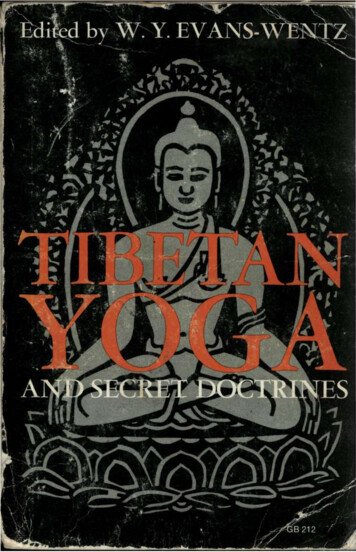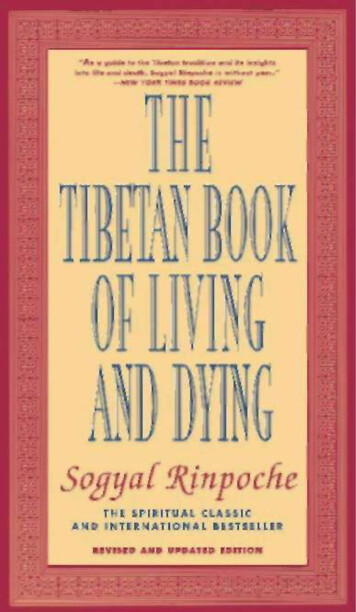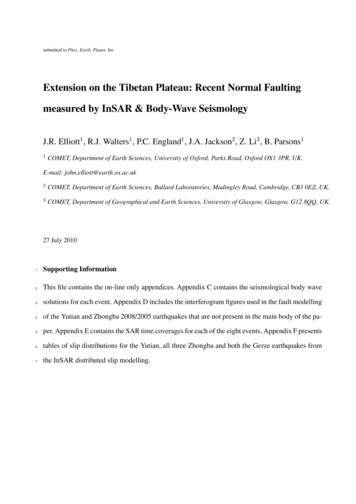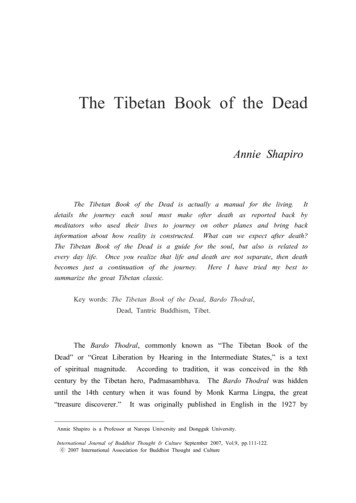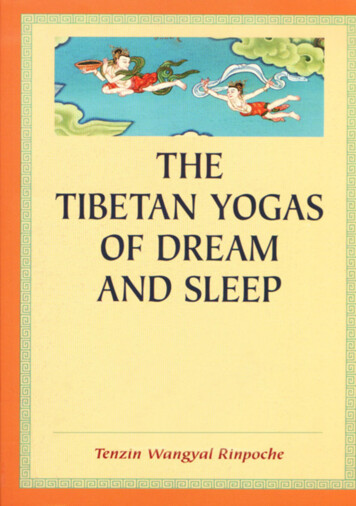
Transcription
TIBETAN YOGAS OF DREAM AND SLEEPTenzin Wangyal RinpocheEdited byMark DahlbySnow Lion PublicationsIthaca, New York
This e-Book was made with Scansoft OmniPage 15 Pro OCR suite. Do not sell thiscopy. It is intended for educational purposes only! Remember, if you like it, buy it!
Table of RECEIVING THE TEACHINGS.14PART ONE.18The Nature of Dream.181. Dream and Reality.192. How Experience Arises.20IGNORANCE.20ACTIONS AND RESULTS: KARMA AND KARMIC TRACES.21NEGATIVE KARMA.23POSITIVE KARMA.24LIBERATING EMOTIONS.24OBSCURATIONS OF CONSCIOUSNESS.26KARMIC TRACES AND DREAM.26THE SIX REALMS OF CYCLIC EXISTENCE.27Hell Realm.30Hungry Ghost Realm.31Animal Realm.31Human Realm.32Demigod Realm.32God Realm.33WHY "NEGATIVE" EMOTION?.333. The Energy Body.35CHANNELS AND PRANA.35CHANNELS (TSA).36PRANA (LUNG).37Karmic Prana.37Three Kinds of Karmic Prana.38Wisdom Prana.38Pranic Activity.38BALANCING THE PRANA.38PRANA AND MIND.39CHAKRAS.40BLIND HORSE, LAME RIDER.414. Summary: How Dreams Arise.435 Images from the Mother Tantra.44TEACHING METAPHORS.46PART TWO.48Kinds and Uses of Dreams.481. Three Kinds of Dreams.49SAMSARIC DREAMS.49DREAMS OF CLARITY.49CLEAR LIGHT DREAMS.50
2. Uses of Dreams.52EXPERIENCE IN DREAM.52GUIDANCE AND GUIDELINES.52DIVINATION.54TEACHINGS IN DREAM.563. The Discovery of Chöd Practice.584. Two Levels of Practice.61PART THREE.64The Practice of Dream Yoga.641. Vision, Action, Dream, Death.652. Calm Abiding: Zhiné.67FORCEFUL ZHINÉ.69NATURAL ZHINÉ.70ULTIMATE ty.713. The Four Foundational Practices.72ONE: CHANGING THE KARMIC TRACES.72TWO: REMOVING GRASPING AND AVERSION.74THREE: STRENGTHENING INTENTION.75FOUR: CULTIVATING MEMORY AND JOYFUL EFFORT.76CONSISTENCY.764. Preparation for the Night.78NINE PURIFICATIONS BREATHING.78First Three Breaths.79Second Three Breaths.79Third Three Breaths.79GURU YOGA.80The Practice.81PROTECTION.825. The Main Practice.84BRINGING AWARENESS INTO THE CENTRAL CHANNEL.84INCREASING CLARITY.85STRENGTHENING PRESENCE.87DEVELOPING FEARLESSNESS.88POSITION.89FOCUSING THE MIND.90THE SEQUENCE.936. Lucidity.96DEVELOPING FLEXIBILITY.977. The N.104
FORGETTING.104FOUR OBSTACLES ACCORDING TO SHARDZA RINPOCHE.1048. Controlling and Respecting Dreams.1069. Simple Practices.108THE WAKING MIND.10810. Integration.110PART FOUR.112Sleep.1121. Sleep and Falling Asleep.1132. Three Kinds of Sleep.114SLEEP OF IGNORANCE.114SAMSARIC SLEEP.114CLEAR LIGHT SLEEP.1143. Sleep Practice and Dream Practice.116PART FIVE.118The Practice of Sleep Yoga.1181. The Dakini, Salgye Du Dalma.1192. Preliminary Practice.1223. Sleep Practice.123ENTERING SLEEP.1234. Tiglé.1265. Progress.1276. Obstacles.1287. Supportive R.131DISSOLVING.131EXPANDING AND CONTRACTING.1318. Integration.133INTEGRATION OF CLEAR LIGHT WITH THE THREE POISONS .133INTEGRATION WITH THE CYCLES OF TIME.135External Unification: Integrating the Clear Light into the Cycle of Dayand Night.135Internal Unification: Integrating the Clear Light into the Sleep Cycle.137Secret Unification: Integrating the Clear Light with the Bardo.138The Three Unifications: Conclusion.1399. Continuity.140PART SIX.141Elaborations.1411. Context.1422. Mind and Rigpa.143CONCEPTUAL MIND.143NON-DUAL AWARENESS: RIGPA.144
Base Rigpa and Path Rigpa.1453. The Base: Kunzhi.146MIND AND MATTER.1464. Knowing.1485. Recognizing Clarity and Emptiness.150BALANCE.151DISCRIMINATION.1516. Self.1537. Paradox of the Essenceless Self.155Final Words.156Appendix: Outline of Dream Yoga Practices.159THE FOUR FOUNDATIONAL PRACTICES.159Changing the Karmic Traces.159Removing Grasping and Aversion.159Strengthening Intention.159Cultivating Memory and Joyful Effort.159PREPARATORY PRACTICES BEFORE SLEEP.160Nine Purifications Breathing.160Guru Yoga.160Protection.160THE MAIN PRACTICES.160Bringing Awareness into the Central Channels.160Increasing Clarity.160Strengthening Presence.160Developing Fearlessness.161Glossary.162Bibliography.168
AcknowledgmentsI want to thank the people who have been instrumental in bringing this book topublication. First of all, and most importantly, Mark Dahlby, my student andclose friend, with whom I greatly enjoyed working. We spent many hoursdiscussing different issues in cafes around Berkeley. Without him, this bookwould not have been possible.Also: Steven D. Goodman, a colleague and friend, improved the manuscriptthrough numerous good suggestions; Sue Ellis Dyer and Chris Baker madeediting suggestions on an early version of the book; Sue Davis and LauraShekerjian helped by reading the text and offering feedback; and Christine Coxof Snow Lion Publications brought her great skill as an experienced editor tothe text and made it a much better book.The photographs of the meditation and dream yoga positions, on pages 85and 109 respectively, were taken by Antonio Riestra and modeled by LuzVergara. The illustrations of the chakras on pages 105 and 107 were created byMonica R. Ortega. I also want to thank all those I have not named but who havehelped in many different ways.
This book is dedicated to Namkhai Norbu Rinpoche,who has been a great inspiration in my life,both in how I teach others and in my own practice.
PrefaceA well-known saying in Tibetan states, "One should explain the lineage and thehistory in order to cut doubt about the authenticity of the teaching and thetransmission." Therefore, I begin this book with a short story of my life.I was born shortly after my parents fled the Chinese oppression in Tibet.Conditions were difficult and my parents placed me in a Christian boardingschool, where they hoped I would be cared for. My father was a Buddhistlama*, my mother a practitioner of Bön*. Some time after, my father died.Eventually my mother remarried a man who was a Bön lama. Both he and mymother desired that I live within my culture, and when I was ten years old I wastaken to the main Bön monastery in Dolanji, India, and ordained as a monk.After living in the monastery for some time, I was recognized by Lopon(Head Teacher) Sangye Tenzin Rinpoche as the reincarnation of KhyungtulRinpoche, a famous scholar, teacher, author, and meditation master. He waswell known as a master astrologer, and in western Tibet and northern India wasfamous as a tamer of wild spirits. He was widely sought after as a healer withmagical abilities. One of his sponsors was a local king of Himachal in NorthernIndia. This king and his wife, unable to bear children, asked KhyungtulRinpoche to heal them, which he did. The son that they bore and raised is thepresent day Chief Minister of Himachal Pradesh, Virbhardur.When I was thirteen, my kind root master, Lopon Sangye Tenzin, a man ofgreat knowledge and realization, prepared to teach one of the most importantand esoteric teachings in the Bön religion: the Great Perfection (Dzogchen*)lineage of the Oral Transmission of Zhang Zhung (Zhang Zhung Nyan Gyud*).Even though I was still young, my step-father visited Lopon Rinpoche andasked that I be admitted to the teachings, which would take place every day forthree years. Lopon kindly agreed, but asked that I, along with the otherprospective students, bring him a dream from the night before the teachingswere to begin, so that he might determine our readiness.Some of the students remembered no dream, which was considered a sign ofobstacles. Lopon had them begin appropriate purification practices and delayedthe beginning of the teaching until each student did have a dream. Dreams ofother students were taken as indications that they needed to do particularpractices to ready themselves for the teachings for example, doing practices thatstrengthened their connections to the Bön guardians*.I dreamed about a bus circumambulating my teacher's house, although thereis actually no road there. In the dream, the bus conductor was my friend and Istood beside him, handing out tickets to each person that boarded the bus. Thetickets were pieces of paper that had the Tibetan syllable A written on them.That was in the second or third year of my education at Dolanji, when I wasthirteen years old, and at the time I did not know that A was a symbol of majorsignificance in Dzogchen teachings. My teacher never said anything about thedream, which was his way. He made little comment about what was good, but I
was happy as long as I was allowed to come to the teachings.It is common, in Tibetan spiritual traditions, for dreams of the students to beused by the teacher in this fashion to determine if it is appropriate for a studentto receive a particular teaching. Though it would be some time before I began tostudy and practice dream yoga, this incident was the beginning of my interest indreams. It strongly impressed on me how greatly dream is valued in Tibetanculture and in the Bön religion, and how information from the unconscious isoften of greater value than the information the conscious mind can provide.After the three-year teaching, which included numerous meditation retreatswith my fellow practitioners as well as many retreats that I did alone, I enteredthe monastic Dialectic School. The program of study normally takes nine tothirteen years to complete and covers the traditional training. We were taughtthe common academic subjects, such as grammar, Sanskrit, poetry, astrology,and art, and also learned the uncommon subjects: epistemology, cosmology,sutra*, tantra* and Dzogchen. During the monastic training, I was exposed to anumber of teachings and transmissions on dream, the most important based onthe texts of the Zhang Zhung Nyan Gyud, the Mother Tantra, and of ShardzaRinpoche.I did well in the training and when 1 was nineteen I was asked to beginteaching others, which I did. Around the same time I wrote and published asummary of the biography of Lord Shenrab Miwoche*, the founder of the Bönreligion. Later I became the president of the Dialectic School and held thatposition for four years, and was very involved in shaping and developing theschool. In 1986, I received the Geshe degree, the highest degree awarded inTibetan monastic education.In 1989, at the invitation of Namkhai Norbu Rinpoche's DzogchenCommunity in Italy, I traveled to the West. Although I had no plans to teach, Iwas invited to do so by members of the community. One day I was passing outsmall pieces of paper to be used in a meditation on concentration. Each piece ofpaper had the Tibetan syllable A written on it. Right then the dream from fifteenyears before, in which I passed out the same paper to people getting on the bus,came back to me. It was as if it hit me on the head.I remained in the West and in 1991 was awarded a Rockefeller Fellowship todo research at Rice University. In 1993, I published my first book in the West,The Wonders of the Natural Mind, in which I tried to present the GreatPerfection (Dzogchen) teachings in a clear and simple way. In 1994 I was givena grant from The National Endowment for the Humanities to pursue research onthe logical and philosophical aspects of the Bön tradition, in collaboration withProfessor Anne Klein, Chair of Religious Studies, at Rice University.So my scholarly side has continued to manifest, but practice is always moreimportant, and during all this time I have been interested in dream and dreampractice. My interest is not only theoretical. I have trusted the wisdom of mydreams, influenced from an early age by the dream experiences of my teachersand my mother and by the use of dreams in the Bön tradition, and I have beenpracticing dream yoga intensively during the last ten years. Every night when Iget into bed, I feel freedom. The busyness of the day is over. Some nights the
practice is successful and some nights it is not, and that is to be expected untilthe practice is very advanced. Nevertheless, I go to sleep nearly every nightwith the intention to accomplish dream practice. It is from my own experiencewith the practice, as well as from the three texts that I quote above, that theteachings in this book come.The Tibetan Yogas of Dream and Sleep grew out of oral teachings I gave inCalifornia and New Mexico over several years. Much of the informality thatwas part of the teachings has been kept. Words marked with an asterisk upontheir first appearance in the text can be found in the glossary at the back of thebook.Dream yoga is a primary support in developing my own practice and this hasbeen true for many, many masters and yogis* of Tibet. For example, I havealways been impressed with the story of Shardza Rinpoche, a great Tibetanmaster who, when he died in 1934, attained the body of light (jalus*), a sign offull realization. During his life he had many accomplished students, wrote manyimportant texts, and worked for the benefit of the country in which he lived. It'sdifficult to imagine how he could have been so productive in his external life,fulfilling the many responsibilities and long projects he undertook for thebenefit of others, and still have been able to accomplish such attainmentthrough spiritual practice. He could do this because he was not a writer for partof the day, a teacher for another part, and a practitioner for the few hours left.All of his life was practice, whether he was sitting in meditation, writing,teaching, or sleeping. He writes that dream practice was of central importancein his spiritual journey and integral to his attainment. This can also be true forus.
IntroductionWe spend a third of our life sleeping. No matter what we do, however virtuousor non-virtuous our activities, whether we are murderers or saints, monks orlibertines, every day ends the same. We shut our eyes and dissolve intodarkness. We do so fearlessly, even as everything we know as "me" disappears.After a brief period, images arise and our sense of self arises with them. Weexist again in the apparently limitless world of dream. Every night weparticipate in these most profound mysteries, moving from one dimension ofexperience to another, losing our sense of self and finding it again, and yet wetake it all for granted. We wake in the morning and continue in "real" life, but ina sense we are still asleep and dreaming. The teachings tell us that we cancontinue in this deluded, dreamy state, day and night, or wake up to the truth.When we engage in sleep and dream yogas we become part of a longlineage. Men and women have - for centuries - done these same practices,confronted the same doubts and obstacles that we do, and received the samebenefits that we can. Many high lamas and accomplished yogis have madesleep and dream yogas primary practices, and through them have attainedrealization. Reflecting on this history and remembering the people who havededicated their lives to the teachings - our spiritual ancestors who through theseteachings pass to us the fruits of their practice - will generate faith in andgratitude for the tradition.Some Tibetan masters might find it strange that I teach these practices toWesterners who have not done certain preliminary practices or who do not havecertain understandings. The teachings were traditionally maintained as secretteachings, both as a sign of respect and as a protection against dilution throughthe misunderstanding of unprepared practitioners. They were never taughtpublicly nor given lightly, but were reserved for individuals who had preparedto receive them.The practices are no less efficacious and valuable then they ever were,but conditions in the world have changed, and so I am trying somethingdifferent. I hope that by teaching what is effective, openly and simply, thetradition will be better preserved and more people will be able to benefit fromit. But it is important to respect the teachings, both to protect them and tofurther our own practice. Please try to receive the direct transmission of theseteachings from an authentic teacher. It is good to read about these yogas butbetter to receive the oral transmission, which creates a stronger connection withthe lineage. Also, it is easy to encounter obstacles on the path that are hard toovercome on our own but which an experienced teacher can identify and help toremove. This is an important point that should not be forgotten.Our human lives are precious. We have intact bodies and minds, withcomplete potential. We may have met teachers and received teachings, and wehave lives in which we enjoy the freedom to follow the spiritual path. We knowthat practice is essential to the spiritual journey as well as to our aspiration to
help others. We also know life passes quickly and death is certain, yet in ourbusy lives we find it difficult to practice as much as we wish we could. Perhapswe meditate for an hour or two each day, but that leaves the other twenty-twohours in which to be distracted and tossed about on the waves of samsara*. Butthere is always time for sleep; the third of our lives we spend sleeping can beused for practice.A main theme of this book is that through practice we can cultivategreater awareness during every moment of life. If we do, freedom andflexibility continually increase and we are less governed by habitualpreoccupations and distractions. We develop a stable and vivid presence thatallows us to more skillfully choose positive responses to whatever arises,responses that best benefit others and our own spiritual journey. Eventually wedevelop a continuity of awareness that allows us to maintain full awarenessduring dream as well as in waking life. Then we are able to respond to dreamphenomena in creative and positive ways and can accomplish various practicesin the dream state. When we fully develop this capacity, we will find that we areliving both waking and dreaming life with greater ease, comfort, clarity, andapprecia
This e-Book was made with Scansoft OmniPage 15 Pro OCR suite. Do not sell this copy. It is intended for edu
